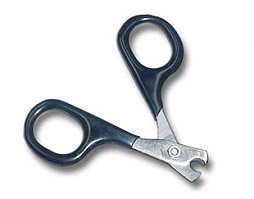The easiest way to cut your Papillon’s nails is by placing in standing position. Holding the foot, gently press on your dog’s paw pad to extend the toenail. Using your clippers, snip off just the hook-like end of the nail on a 45-degree angle. Remember, taking too little is better than cutting too much.
Repeat this process on all your dog’s nails, including dew claws if present. Finish each session by walking your Papillon on a coarse surface such as pavement or concrete, which helps smooth any rough edges on the nails. You may also use an emery board for this purpose. Some dog owners prefer using a nail grinder to trim their pets’ nails. This hand-held rotary tool works like a high-speed emery board. If you think this device may work well for you, ask your dog’s veterinarian to show you how to use it properly before trying it out on your Papillon.
Although any wounds that might result from a grinder will be instantly cauterized, they can still hurt. Also, be careful not to allow any fur to wrap around the spinning rotary bit.
Although accidents may happen from time to time, be sum you aren’t cutting your Papillon’s quick too frequently. If you are, consider deferring the task to a professional groomer or your dog’s veterinarian. This is preferable to injuring your pet on a regular basis. Your dog will forgive an occasional accident, but frequent mishaps could cause him to fear nail cutting and could even lead to a dangerous infection.
When to Trim
The rates at which different dogs’ nails grow can differ dramatically between individuals, but this task should generally be performed at least once every two to three weeks. As soon as you can hear your dog’s nails on the floor, he is already overdue for a trim. Walking on feet with overgrown toenails is painful for your pet, so don’t let this happen. It is better to snip just a tiny bit off his nails more frequently than cut off a longer amount less often.
In the former scenario, the quick actually begins to recede in response to the steady trimming, making cutting the quick a much less likely possibility. Trimming more frequently will also help your dog avoid painful accidents, like snagging his nails in clothing, carpeting, and even his own fur.
The Quick
What makes nail trimming so daunting is a little thing called the quick—that sensitive, pink area of the nail (also known as the nailbed) that bleeds if accidentally snipped. The two most important things to know before beginning to cut the nails are that first, you will very likely nip your dog’s quick at some point in his life, and second, you can stop the bleeding when it does happen. To do so, hold a cold damp cloth on the wound for 10 to 15 minutes, steadily but gently applying pressure. If bleeding persists beyond this point, use styptic powder or a styptic pencil to help speed clotting. Other items that can be used in a pinch are cornstarch, a bar of soap, or a wet tea bag.
Being able to cut your Papillon’s nails at home, will save you both time and money. It will also increase your confidence for other grooming tasks since this one is by far the most intimidating.
Nail trimming is most easily done on a dog who is used to having his feet handled. We recommend gently massaging your dog’s feet regularly as soon as you bring him home. This truly is half the battle. If your dog insists on pulling his foot away from you when you hold it, safe trimming is considerably more difficult, not to mention stressful for both you and your Papillon. So, in the beginning, don’t even take the clippers out of your grooming bag.
Hassle Free Grooming
Don’t let your Papillon wiggle his way out of being groomed. Even if your dog’s constant squirming makes it difficult to finish a particular task in just one session, be tenacious. For example, insist on cutting at least a few nails before putting the clippers away for the day, ending on a positive note whenever possible.
If you give in to fussing or wiggling, you set a dangerous precedent. Although certain grooming tasks can be enjoyable for your pet, remember that grooming is an excellent way to enforce the hierarchy within your home. By making your dog stand for regular grooming, you remind him that you are the one in charge. Even toy breeds need to understand this chain of command. Your persistence can make your dog more accommodating when grooming time arrives again. Praising your Papillon and offering a tasty treat for compliance are also great ways to encourage continued cooperation.

